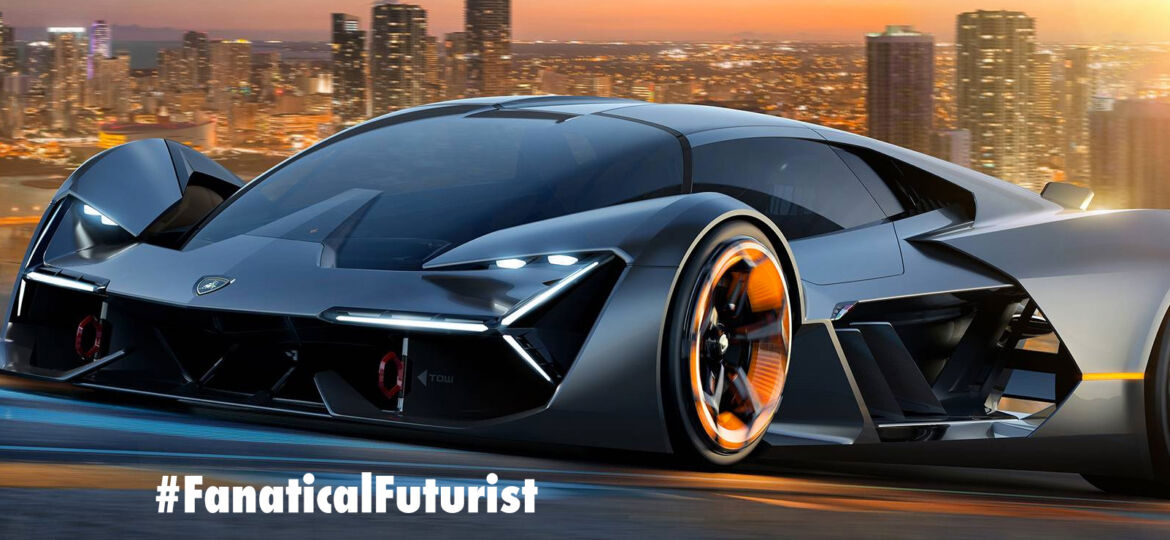
WHY THIS MATTERS IN BRIEF
It’s likely that our flirtation with battery packs in cars won’t last as long as we think as new wirelessly charged cars start emerging, and as new materials let the cars themselves become the batteries.
Lamborghini and MIT recently introduced the Terzo Millennio concept, which translated into english means “Third millennium,” an ultra-futuristic all electric, self-healing hyper car concept, to showcase what the eco-friendly sports car of tomorrow could look like. While the whole package tells a tale set in the relatively distant future the head of Lamborghini’s Research and Development department, Maurizio Reggiani, says that it might not be as sci-fi as it first appears.
Speaking to an audience at a recent motor show in Europe Reggiani said Lamborghini often discusses what a full electric car, that’s made from self-healing materials, could look like and when it might realistically arrive, but his team always comes to the same conclusion, namely that the present day battery technologies used in cars built by the likes of Tesla and others isn’t suitable to power a super sports car like the Aventador S, with the main problems being the weight and the way the batteries are packaged.
“[Our cars] must have a top speed superior to 186 mph, they must be able to run three full laps at full speed on the Nordschleife, and they must have state-of-the-art handling. You cannot do this with the current battery technology,” he explained.
As it stands, a majority of existing and upcoming electric vehicles destined for volume production use a skateboard-like chassis that places a Lithium Ion (LiON) battery pack roughly as big as a queen sized mattress between the axles. This solution works particularly well for crossovers and SUVs, but it doesn’t cut it for Lamborghini because it creates packaging constraints and adds far too much weight. The answer, according to Reggiani, likely lies in state of the art rechargeable body panels.
The Terzo Millennio concept partially illustrates that it’s already technically possible to store energy not just in the car’s carbon fiber body panels, but even suspension components and the seat backs. In fact anything that’s made with the lightweight composite material is fair game, and it’s a future ground breaking technology the brightest minds from Lamborghini and MIT are working to turn into a reality. The first iteration of the car will likely store energy in carbon fiber nanotubes which are capable of releasing energy faster than batteries – ideal for performance. They also cut down on weight compared to batteries, ending the tradeoff between battery size and vehicle mass.
Reggiani stresses though that, in his opinion, offsetting the weight of an electric drivetrain by storing energy in the body panels is the only way to make a hyper sports car electric. So, what does the future hold for the Terzo Millennio and the technology it demonstrates? Well, as ever, it ultimately depends on a variety of factors, including some outside of the brand’s control.
“I can tell you the research project [with MIT] will finish in three years. When we arrive at the end of the project we’ll decide whether it’s yes or no. Assuming it’s a yes, you need about two years for industrialization. Plus, you need another five years to put a car in production. That means, theoretically, in 2030 you could have a full electric Lamborghini. If something fails we’ll say no,” Reggiani clarified.
Reading between the lines, his comments all but confirm the current Aventador’s successor won’t arrive as an electric vehicle, or at least a purely electric one at least, but inevitably, as our knowledge of materials, supercapacitors and superconductors continue to advance, and as we close in on new materials that can store and release energy fast and efficiently, then it might not be long before we can ditch those big old battery packs altogether and create gorgeous hyper cars that never need to plug in, and never need to stop at a petrol station ever again.

















[…] been saying for years now that electric vehicles won’t always be powered by big bulky Lithium Ion (LiON) batteries and […]